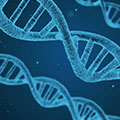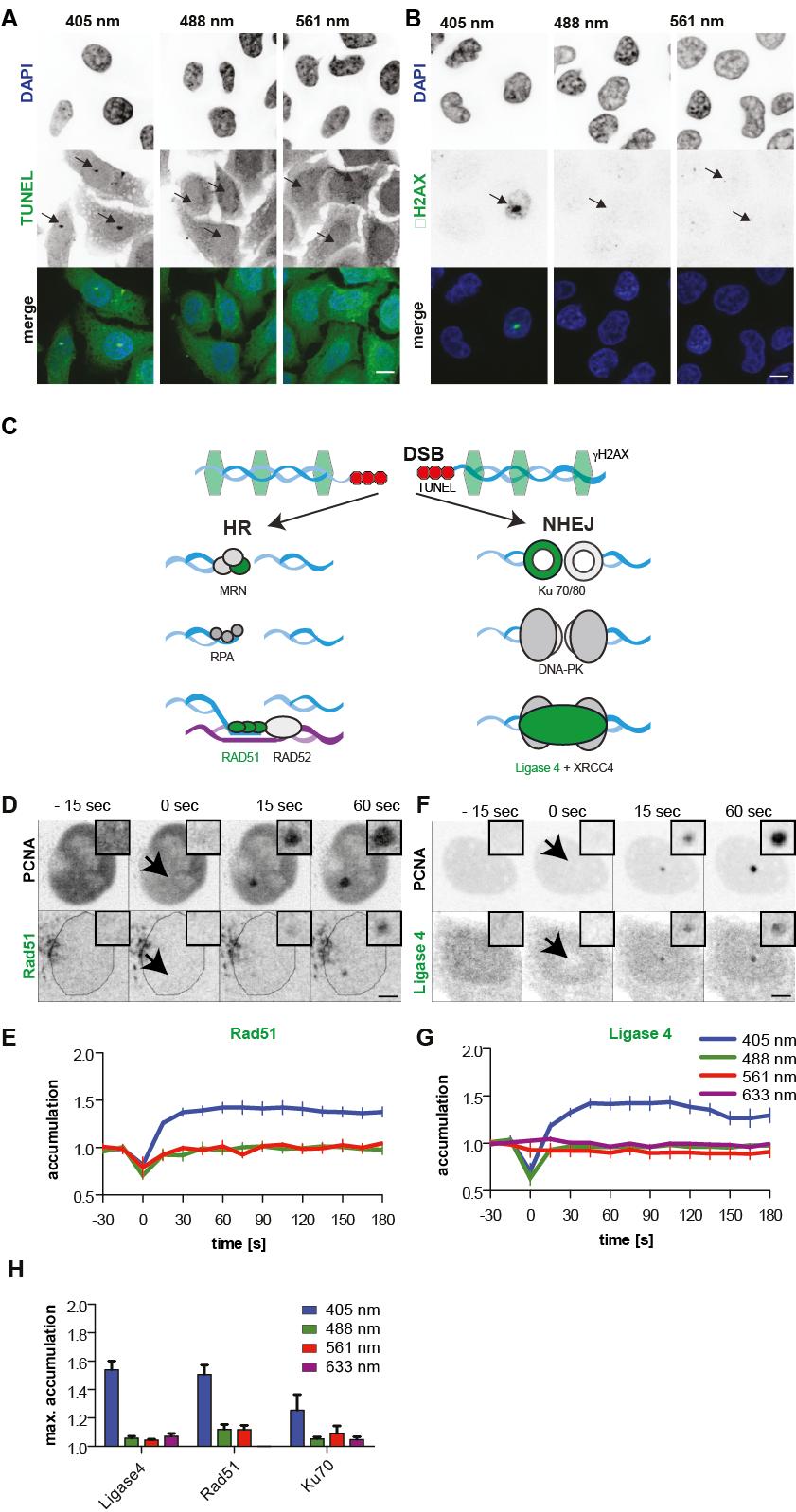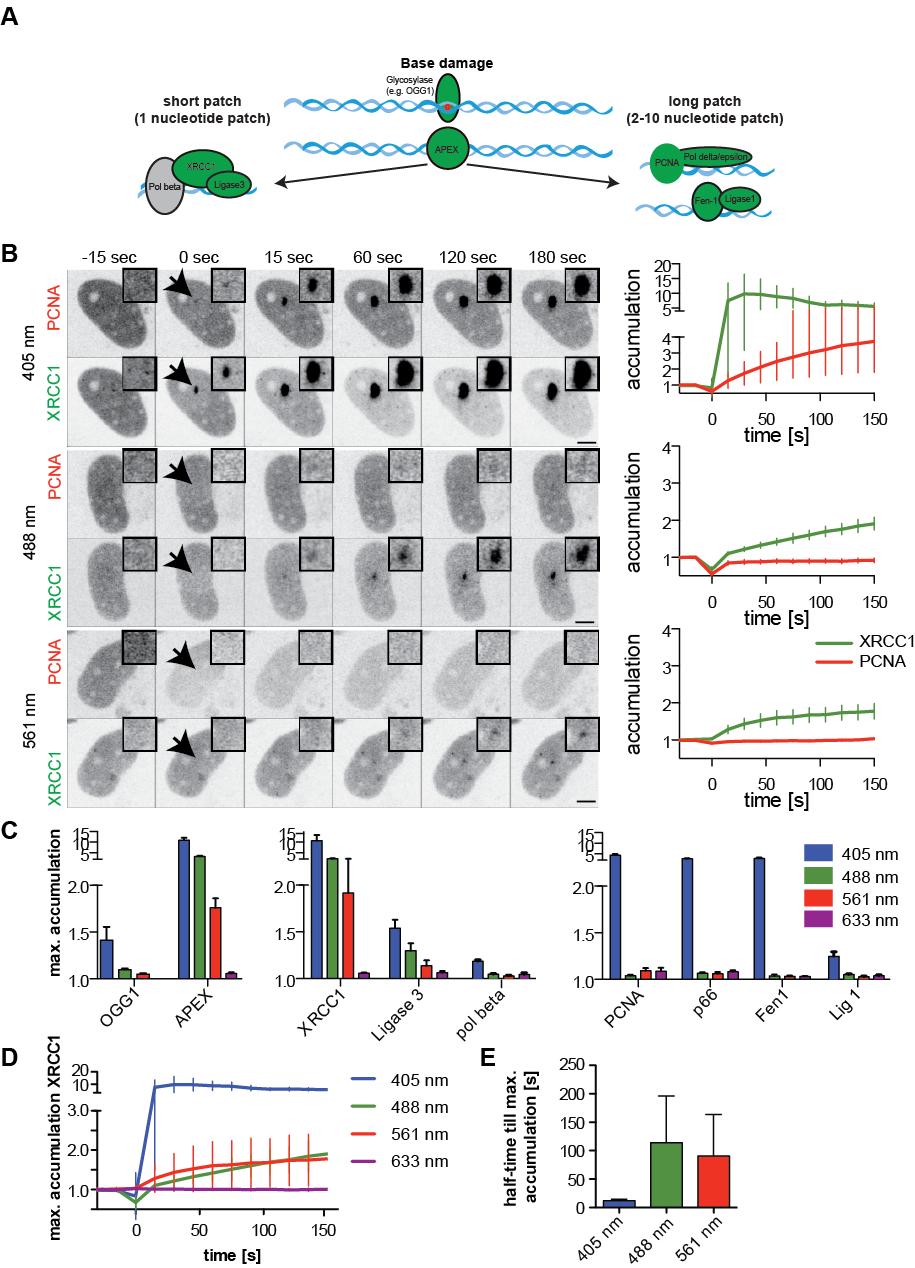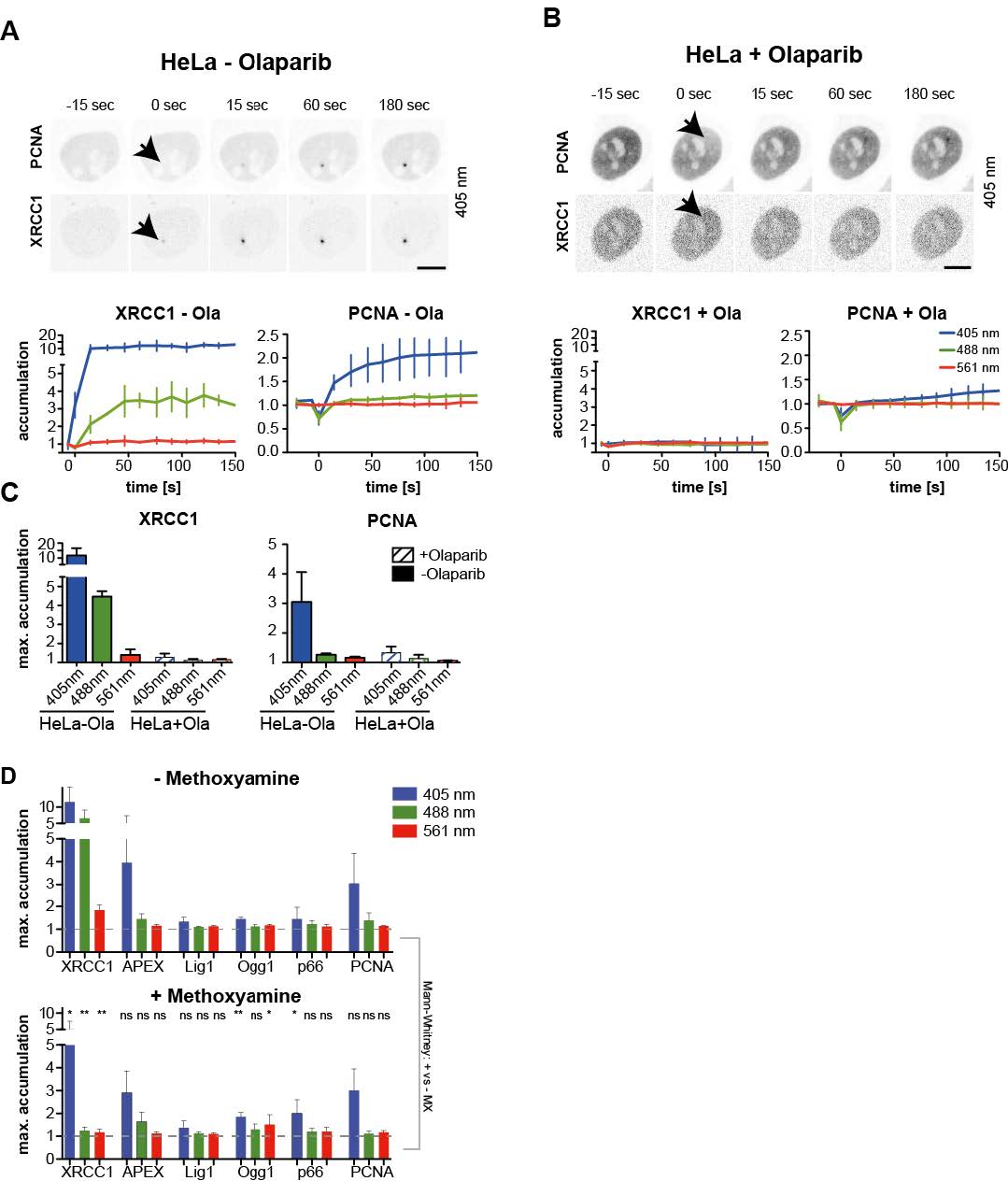|
[1]
|
Hegde ML, Hazra TK, Mitra S (2008) Early steps in the DNA base excision/single-strand interruption repair pathway in mammalian cells. Cell Res 18: 27-47. doi: 10.1038/cr.2008.8

|
|
[2]
|
Hoeijmakers JH (2009) DNA damage, aging, and cancer. N Engl J Med 361: 1475-1485. doi: 10.1056/NEJMra0804615

|
|
[3]
|
Goodarzi AA, Jeggo PA (2013) The repair and signaling responses to DNA double-strand breaks. Adv Genet 82: 1-45.
|
|
[4]
|
Polo SE, Jackson SP (2011) Dynamics of DNA damage response proteins at DNA breaks: a focus on protein modifications. Genes Dev 25: 409-433. doi: 10.1101/gad.2021311

|
|
[5]
|
Mortusewicz O, Leonhardt H, Cardoso MC (2008) Spatiotemporal dynamics of regulatory protein recruitment at DNA damage sites. J CELL Biochem 104: 1562-1569. doi: 10.1002/jcb.21751

|
|
[6]
|
Gassman NR, Wilson SH (2015) Micro-irradiation tools to visualize base excision repair and single-strand break repair. DNA Repair 31: 52-63. doi: 10.1016/j.dnarep.2015.05.001

|
|
[7]
|
Lengert L, Lengert N, Drossel B, et al. (2015) Discrimination of Kinetic Models by a Combination of Microirradiation and Fluorescence Photobleaching. Biophys J 109: 1551-1564. doi: 10.1016/j.bpj.2015.08.031

|
|
[8]
|
Bekker-Jensen S, Lukas C, Kitagawa R, et al. (2006) Spatial organization of the mammalian genome surveillance machinery in response to DNA strand breaks. J Cell Biol 173: 195-206. doi: 10.1083/jcb.200510130

|
|
[9]
|
Cremer C, Cremer T, Fukuda M, et al. (1980) Detection of laser--UV microirradiation-induced DNA photolesions by immunofluorescent staining. Hum Genet 54: 107-110. doi: 10.1007/BF00279058

|
|
[10]
|
Lukas C, Falck J, Bartkova J, et al. (2003) Distinct spatiotemporal dynamics of mammalian checkpoint regulators induced by DNA damage. Nat Cell Biol 5: 255-260. doi: 10.1038/ncb945

|
|
[11]
|
Lukas C, Melander F, Stucki M, et al. (2004) Mdc1 couples DNA double-strand break recognition by Nbs1 with its H2AX-dependent chromatin retention. EMBO J 23: 2674-2683. doi: 10.1038/sj.emboj.7600269

|
|
[12]
|
Rogakou EP, Boon C, Redon C, et al. (1999) Megabase chromatin domains involved in DNA double-strand breaks in vivo. J Cell Biol 146: 905-916. doi: 10.1083/jcb.146.5.905

|
|
[13]
|
Tashiro S, Walter J, Shinohara A, et al. (2000) Rad51 accumulation at sites of DNA damage and in postreplicative chromatin. J Cell Biol 150: 283-291. doi: 10.1083/jcb.150.2.283

|
|
[14]
|
Kong X, Mohanty SK, Stephens J, et al. (2009) Comparative analysis of different laser systems to study cellular responses to DNA damage in mammalian cells. Nucleic Acids Res 37: e68. doi: 10.1093/nar/gkp221

|
|
[15]
|
Dinant C, de Jager M, Essers J, et al. (2007) Activation of multiple DNA repair pathways by sub-nuclear damage induction methods. J Cell Sci 120: 2731-2740. doi: 10.1242/jcs.004523

|
|
[16]
|
Lan L, Nakajima S, Oohata Y, et al. (2004) In situ analysis of repair processes for oxidative DNA damage in mammalian cells. Proc Natl Acad Sci U S A 101: 13738-13743. doi: 10.1073/pnas.0406048101

|
|
[17]
|
Mortusewicz O, Leonhardt H (2007) XRCC1 and PCNA are loading platforms with distinct kinetic properties and different capacities to respond to multiple DNA lesions. BMC molecular biology 8: 81. doi: 10.1186/1471-2199-8-81

|
|
[18]
|
Mortusewicz O, Rothbauer U, Cardoso MC, et al. (2006) Differential recruitment of DNA Ligase I and III to DNA repair sites. Nucleic Acids Res 34: 3523-3532. doi: 10.1093/nar/gkl492

|
|
[19]
|
Mortusewicz O, Schermelleh L, Walter J, et al. (2005) Recruitment of DNA methyltransferase I to DNA repair sites. Proc Natl Acad Sci U S A 102: 8905-8909. doi: 10.1073/pnas.0501034102

|
|
[20]
|
Campalans A, Kortulewski T, Amouroux R, et al. (2013) Distinct spatiotemporal patterns and PARP dependence of XRCC1 recruitment to single-strand break and base excision repair. Nucleic Acids Res 41: 3115-3129. doi: 10.1093/nar/gkt025

|
|
[21]
|
Menoni H, Hoeijmakers JH, Vermeulen W (2012) Nucleotide excision repair-initiating proteins bind to oxidative DNA lesions in vivo. J Cell Biol 199: 1037-1046. doi: 10.1083/jcb.201205149

|
|
[22]
|
Reynolds P, Botchway SW, Parker AW, et al. (2013) Spatiotemporal dynamics of DNA repair proteins following laser microbeam induced DNA damage - when is a DSB not a DSB? Mutat Res 756: 14-20. doi: 10.1016/j.mrgentox.2013.05.006

|
|
[23]
|
Trautlein D, Deibler M, Leitenstorfer A, et al. (2010) Specific local induction of DNA strand breaks by infrared multi-photon absorption. Nucleic Acids Res 38: e14. doi: 10.1093/nar/gkp932

|
|
[24]
|
Fischer JM, Popp O, Gebhard D, et al. (2014) Poly(ADP-ribose)-mediated interplay of XPA and PARP1 leads to reciprocal regulation of protein function. FEBS J 281: 3625-3641. doi: 10.1111/febs.12885

|
|
[25]
|
Reynolds P, Anderson JA, Harper JV, et al. (2012) The dynamics of Ku70/80 and DNA-PKcs at DSBs induced by ionizing radiation is dependent on the complexity of damage. Nucleic Acids Res 40: 10821-10831. doi: 10.1093/nar/gks879

|
|
[26]
|
Ferrando-May E, Tomas M, Blumhardt P, et al. (2013) Highlighting the DNA damage response with ultrashort laser pulses in the near infrared and kinetic modeling. Front Genet 4: 135.
|
|
[27]
|
Mohanty SK, Rapp A, Monajembashi S, et al. (2002) Comet assay measurements of DNA damage in cells by laser microbeams and trapping beams with wavelengths spanning a range of 308 nm to 1064 nm. Radiat Res 157: 378-385.
|
|
[28]
|
Kim JS, Heale JT, Zeng W, et al. (2007) In situ analysis of DNA damage response and repair using laser microirradiation. Methods Cell Biol 82: 377-407. doi: 10.1016/S0091-679X(06)82013-3

|
|
[29]
|
Landry JJ, Pyl PT, Rausch T, et al. (2013) The genomic and transcriptomic landscape of a HeLa cell line. G3 (Bethesda) 3: 1213-1224. doi: 10.1534/g3.113.005777

|
|
[30]
|
Trucco C, Oliver FJ, de Murcia G, et al. (1998) DNA repair defect in poly(ADP-ribose) polymerase-deficient cell lines. Nucleic Acids Res 26: 2644-2649. doi: 10.1093/nar/26.11.2644

|
|
[31]
|
Oshima RG, Pellett OL, Robb JA, et al. (1977) Transformation of human cystinotic fibroblasts by SV40: characteristics of transformed cells with limited and unlimited growth potential. J Cell Physiol 93: 129-136. doi: 10.1002/jcp.1040930116

|
|
[32]
|
Chagin VO, Casas-Delucchi CS, Reinhart M, et al. (2016) 4D Visualization of replication foci in mammalian cells corresponding to individual replicons. Nat Commun 7: 11231. doi: 10.1038/ncomms11231

|
|
[33]
|
Casas-Delucchi CS, Becker A, Bolius JJ, et al. (2012) Targeted manipulation of heterochromatin rescues MeCP2 Rett mutants and re-establishes higher order chromatin organization. Nucleic Acids Res 40: e176. doi: 10.1093/nar/gks784

|
|
[34]
|
Mortusewicz O, Fouquerel E, Ame JC, et al. (2011) PARG is recruited to DNA damage sites through poly(ADP-ribose)- and PCNA-dependent mechanisms. Nucleic Acids Res 39: 5045-5056. doi: 10.1093/nar/gkr099

|
|
[35]
|
Sporbert A, Domaing P, Leonhardt H, et al. (2005) PCNA acts as a stationary loading platform for transiently interacting Okazaki fragment maturation proteins. Nucleic Acids Res 33: 3521-3528. doi: 10.1093/nar/gki665

|
|
[36]
|
Rodgers W, Jordan SJ, Capra JD (2002) Transient association of Ku with nuclear substrates characterized using fluorescence photobleaching. J Immunol 168: 2348-2355. doi: 10.4049/jimmunol.168.5.2348

|
|
[37]
|
Bergink S, Toussaint W, Luijsterburg MS, et al. (2012) Recognition of DNA damage by XPC coincides with disruption of the XPC-RAD23 complex. J Cell Biol 196: 681-688. doi: 10.1083/jcb.201107050

|
|
[38]
|
Hoogstraten D, Bergink S, Ng JM, et al. (2008) Versatile DNA damage detection by the global genome nucleotide excision repair protein XPC. J Cell Sci 121: 2850-2859. doi: 10.1242/jcs.031708

|
|
[39]
|
Pohler JR, Otterlei M, Warbrick E (2005) An in vivo analysis of the localisation and interactions of human p66 DNA polymerase delta subunit. BMC molecular biology 6: 17. doi: 10.1186/1471-2199-6-17

|
|
[40]
|
Grigaravicius P, Greulich KO, Monajembashi S (2009) Laser microbeams and optical tweezers in ageing research. ChemPhysChem 10: 79-85. doi: 10.1002/cphc.200800725

|
|
[41]
|
Henricksen LA, Umbricht CB, Wold MS (1994) Recombinant replication protein A: expression, complex formation, and functional characterization. J Biol Chem 269: 11121-11132.
|
|
[42]
|
Tang JB, Goellner EM, Wang XH, et al. (2010) Bioenergetic metabolites regulate base excision repair-dependent cell death in response to DNA damage. Mol Cancer Res 8: 67-79. doi: 10.1158/1541-7786.MCR-09-0411

|
|
[43]
|
Sakaue-Sawano A, Kurokawa H, Morimura T, et al. (2008) Visualizing spatiotemporal dynamics of multicellular cell-cycle progression. Cell 132: 487-498. doi: 10.1016/j.cell.2007.12.033

|
|
[44]
|
Lan L, Nakajima S, Komatsu K, et al. (2005) Accumulation of Werner protein at DNA double-strand breaks in human cells. J Cell Sci 118: 4153-4162. doi: 10.1242/jcs.02544

|
|
[45]
|
Splinter J, Jakob B, Lang M, et al. (2010) Biological dose estimation of UVA laser microirradiation utilizing charged particle-induced protein foci. Mutagenesis 25: 289-297. doi: 10.1093/mutage/geq005

|
|
[46]
|
Solarczyk KJ, Zarebski M, Dobrucki JW (2012) Inducing local DNA damage by visible light to study chromatin repair. DNA Repair 11: 996-1002. doi: 10.1016/j.dnarep.2012.09.008

|
|
[47]
|
Sutherland JC, Griffin KP (1981) Absorption spectrum of DNA for wavelengths greater than 300 nm. Radiat Res 86: 399-409. doi: 10.2307/3575456

|
|
[48]
|
Greinert R, Volkmer B, Henning S, et al. (2012) UVA-induced DNA double-strand breaks result from the repair of clustered oxidative DNA damages. Nucleic Acids Res 40: 10263-10273. doi: 10.1093/nar/gks824

|
|
[49]
|
Kielbassa C, Roza L, Epe B (1997) Wavelength dependence of oxidative DNA damage induced by UV and visible light. Carcinogenesis 18: 811-816. doi: 10.1093/carcin/18.4.811

|
|
[50]
|
Pflaum M, Boiteux S, Epe B (1994) Visible light generates oxidative DNA base modifications in high excess of strand breaks in mammalian cells. Carcinogenesis 15: 297-300. doi: 10.1093/carcin/15.2.297

|
|
[51]
|
Povirk LF, Wubter W, Kohnlein W, et al. (1977) DNA double-strand breaks and alkali-labile bonds produced by bleomycin. Nucleic Acids Res 4: 3573-3580. doi: 10.1093/nar/4.10.3573

|
|
[52]
|
Raderschall E, Bazarov A, Cao J, et al. (2002) Formation of higher-order nuclear Rad51 structures is functionally linked to p21 expression and protection from DNA damage-induced apoptosis. J Cell Sci 115: 153-164.
|
|
[53]
|
Rapp A, Greulich KO (2004) After double-strand break induction by UV-A, homologous recombination and nonhomologous end joining cooperate at the same DSB if both systems are available. J Cell Sci 117: 4935-4945. doi: 10.1242/jcs.01355

|
|
[54]
|
Trujillo KM, Yuan SS, Lee EY, et al. (1998) Nuclease activities in a complex of human recombination and DNA repair factors Rad50, Mre11, and p95. J Biol Chem 273: 21447-21450. doi: 10.1074/jbc.273.34.21447

|
|
[55]
|
Fernandez-Capetillo O, Celeste A, Nussenzweig A (2003) Focusing on foci: H2AX and the recruitment of DNA-damage response factors. Cell Cycle 2: 426-427.
|
|
[56]
|
Cadet J, Mouret S, Ravanat JL, et al. (2012) Photoinduced damage to cellular DNA: direct and photosensitized reactions. Photochem Photobiol 88: 1048-1065. doi: 10.1111/j.1751-1097.2012.01200.x

|
|
[57]
|
Sugasawa K, Okamoto T, Shimizu Y, et al. (2001) A multistep damage recognition mechanism for global genomic nucleotide excision repair. Genes Dev 15: 507-521. doi: 10.1101/gad.866301

|
|
[58]
|
Caldecott KW (2003) XRCC1 and DNA strand break repair. DNA Repair 2: 955-969. doi: 10.1016/S1568-7864(03)00118-6

|
|
[59]
|
Reynolds P, Cooper S, Lomax M, et al. (2015) Disruption of PARP1 function inhibits base excision repair of a sub-set of DNA lesions. Nucleic Acids Res 43: 4028-4038. doi: 10.1093/nar/gkv250

|
|
[60]
|
Strom CE, Johansson F, Uhlen M, et al. (2011) Poly (ADP-ribose) polymerase (PARP) is not involved in base excision repair but PARP inhibition traps a single-strand intermediate. Nucleic Acids Res 39: 3166-3175. doi: 10.1093/nar/gkq1241

|
|
[61]
|
Caldecott KW (2008) Single-strand break repair and genetic disease. Nat Rev Genet 9: 619-631.
|
|
[62]
|
Caldecott KW (2014) DNA single-strand break repair. Exp Cell Res 329: 2-8. doi: 10.1016/j.yexcr.2014.08.027

|
|
[63]
|
Prasad R, Shock DD, Beard WA, et al. (2010) Substrate channeling in mammalian base excision repair pathways: passing the baton. J Biol Chem 285: 40479-40488. doi: 10.1074/jbc.M110.155267

|
|
[64]
|
Underhill C, Toulmonde M, Bonnefoi H (2011) A review of PARP inhibitors: from bench to bedside. Ann Oncol 22: 268-279. doi: 10.1093/annonc/mdq322

|
|
[65]
|
Kleppa L, Mari PO, Larsen E, et al. (2012) Kinetics of endogenous mouse FEN1 in base excision repair. Nucleic Acids Res 40: 9044-9059. doi: 10.1093/nar/gks673

|
|
[66]
|
Liu L, Gerson SL (2004) Therapeutic impact of methoxyamine: blocking repair of abasic sites in the base excision repair pathway. Curr Opin Investig Drugs 5: 623-627.
|
|
[67]
|
Vidal AE, Boiteux S, Hickson ID, et al. (2001) XRCC1 coordinates the initial and late stages of DNA abasic site repair through protein-protein interactions. EMBO J 20: 6530-6539. doi: 10.1093/emboj/20.22.6530

|

















 DownLoad:
DownLoad: